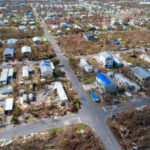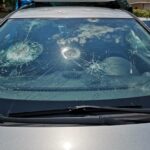Hurricane Jimena weakened to a Category 2 storm as it bore down on the coast of Mexico’s Baja California peninsula.
Jimena’s maximum sustained winds decreased late Tuesday to near 110 mph (175 kph) and the National Hurricane Center in Miami said it was expected to weaken further before making landfall Wednesday.
Jimena’s change in status came a day after the hurricane brushed passed the resort towns at the southern tip of the Baja California, lashing them with driving rain and winds.
Despite the pummeling by the fringes of the then-Category 3 hurricane, the Mexican peninsula’s biggest resort, Los Cabos, appeared to be escaping major damage beyond power outages and mud-choked roads.
Dozens of people evacuated from the Los Congrejos shantytown huddled in darkened rooms at a school after electricity failed during the storm. Trying to calm squalling babies and ignore hunger, the evacuees waited for dawn, and a chance to look at what the hurricane did to their homes made of plastic sheeting, wood and tar paper.
“Instead of giving out a few sheets of roofing every year, they should give us materials to build real houses – wood, or even bricks,” said Paulino Hernandez, an out-of-work mason who sought haven at the school. “Every year it’s the same thing: They (officials) give out a few sheets of roofing, and the next year it has to be replaced” when a hurricane comes.
Authorities reported no injuries or major damages in Los Cabos, but expressed concern about what might happen when the hurricane made landfall farther up the coast.
“It could be ugly at Bahia Magdalena,” state Interior Secretary Luis Armanado Diaz said, referring to a sparsely populated bay with a smattering of fishing villages to the north.
Diaz said the hurricane might actually help alleviate the state’s drought. “If it continues like this, and there is not a major impact, it will help more than it will hurt,” he said.
Officials in Baja California Sur state prepared shelters to hold up to 29,000 people as Jimena churned northward.
The government declared a state of emergency for Los Cabos and the state capital of La Paz as the storm approached. Schools, many ports and most businesses closed. Rescue workers from the Red Cross and the Mexican military prepared for post-hurricane disaster relief, and two Mexican army Hercules cargo planes flew in medical supplies.
Jimena’s core was on course to pass near or over southern Baja California on Wednesday and the central part of the peninsula late Wednesday or early Thursday, according to the U.S. National Hurricane Service.
While its center was missing the peninsula’s resort-studded southern tip, its outer fringes were lashing the resorts, kicking up huge waves and flooding streets.
Residents and tourists gathered Tuesday to watch huge waves batter the shore near Cabo San Lucas, as the wind whipped up sand and salt spray.
Los Cabos resident Eduardo Meraz, 25, went swimming in the pounding surf at the height of the storm, and said he liked it.
“I’m not afraid. I respect the sea,” said Meraz, still dripping from his dip. “The water is nice, but the waves really toss you around.”
Paula Arenas took her 2-year-old nephew Mauro out to a rock outcropping to see the hurricane. “I’ve spent a lot of time living here. We are used to hurricanes,” she said.
Receptionist Martha Pina stood in awe at the entrance to the SolMar hotel on the very tip of the peninsula, watching mountains of roiling, white-capped water slam ashore just yards (meters) beyond the hotel’s swimming pool. “This is the first time I’ve seen them so big … It is beautiful,” Pina said.
All the hotel’s guests – many of whose rooms were just steps from the maelstrom of the sea – were transferred to another hotel as a precaution.
Not everyone found Jimena’s raging show enchanting. Martin Melchior, a 25-year-old construction worker, stood outside his plywood, tin-roofed shack and nervously watched the storm in the Cactus shantytown where he lives. Thin, tattered power cables snaked over the sodden ground to the hundreds of unregistered hookups to the city’s power system.
Police trucks moved through the muddy streets urging people to join an estimated 2,000 residents already in shelters, but Melchior said he wouldn’t go.
“There are too many people in the shelters, and you can’t get any peace. Someone tells you: ‘This is my space,”‘ he said.
Forecasters predicted the hurricane would drop 5 to 10 inches (12 to 25 centimeters) of rain in Baja, and dry stream beds already were gushing torrents.
Most tourists had left by Tuesday, leaving 75 percent of hotel rooms vacant. Some of those who stayed came out to marvel at the storm, fighting the winds and rain at the shore.
Others wandered deserted streets, some ankle-deep in water. “We’re going to go get some more liquor and go back to the room and just watch it,” Mark Lopez, 29, a truck dispatcher from San Jose, California, said while walking near a marina with a half-dozen friends. “We’re making the most of it.”
By late Tuesday night, Jimena was located about 95 miles (155 kilometers) west-southwest of La Paz and about 110 miles (175 kilometers) south-southeast of Cabo San Lazaro.
Local officials say Hurricane Juliet, a Category 4 hurricane on a similar course that killed several people and caused $20.5 million in September 2001, was the most damaging hurricane in storm-prone Baja’s history. That 145-mph (230 kph) storm made a raging 12-day trip through Mexico and the southern United States.
Associated Press writers Martha Mendoza and Julie Watson in Mexico City contributed to this report.
Was this article valuable?
Here are more articles you may enjoy.

 4,800 Claims Handled by Unlicensed Adjusters in Florida After Irma, Lawsuit Says
4,800 Claims Handled by Unlicensed Adjusters in Florida After Irma, Lawsuit Says  EVs Head for Junkyard as Mechanic Shortage Inflates Repair Costs
EVs Head for Junkyard as Mechanic Shortage Inflates Repair Costs  South Carolina Allows Out-of-State Adjusters After Massive Hail Storm
South Carolina Allows Out-of-State Adjusters After Massive Hail Storm  UnitedHealth Data Leak May Affect ‘Substantial’ Swath of U.S.
UnitedHealth Data Leak May Affect ‘Substantial’ Swath of U.S. 